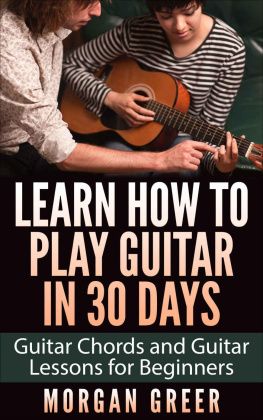Learn Guitar the Easy Way
by Paolo Ocampo
2017 Paolo Ocampo. All rights reserved.
All rights reserved. No portion of this book may be reproduced in any form without permission from the publisher, except as permitted by U.S. copyright law.
Introduction

Have you ever wanted to play the guitar but didn't know where to start?
I know, with so many guitar websites and blogs out there, it's so easy to get overwhelmed.
I created this book, Learn Guitar the Easy Way to teach everyday people how to play the guitar. No, I won't be teaching you how to play the Flamenco, or shred the guitar like Carlos Santana - that would take years, even decades to master.
What you'll learn is a simpler but equally fun way of playing the guitar - using simplified guitar chords!
What are guitar chords, you say? Go to the Youtubes and search for [any song you like] + acoustic cover. See those guys playing the guitar and singing? Yep, they're using guitar chords.
So if you want to be able to jam with your kids, or your friends, or become the next Youtube sensation - this book is for you.
Guitar Chords are really super easy to learn - all you need to do is memorize the 12 Major Chords, that's it. It's actually even easier, because it's really just seven chords - two of them are movable and can be used to generate the other chords (more on that later at the Movable Chords section).
From those 12 Major Chords, you can derive many Chord Variations. These Chord Variations are derived using simple and easy to understand formulas.
With these major chords and its common variations, you can playmost of the songs that you hear on the radio today.
What's more, I'll teach you how to use TheCircle of Fifths and Chord Progressions to predict what chords will be used on any given song. This is the foundation of learning how to play the guitar by ear.
In this book you'll learn:
- How to tune your guitar
- How to play the 18 most commonly played chords
- What are the 12 Major Keys
- How to play the 12 Major Chords using Open and Bar Chords
- How to use Movable Chords
- How to Transpose Chords
- How to spice up Major Chords with Chord Variations
- Learn about Chord Progressions
- Learn about the Circle of Fifths
- Practice with sample songs and video playlists
- Guitar playing tips
- Software, Apps and Resources for Learning Guitar
Are you excited yet? Go ahead and dig into this book, spend a few hours practicing, and impress your girlfriend or boyfriend already!
Types of Guitars
So you may wondering, "What kind of guitar should I get?". (If you already have one, you can skip to the next section)
For those still thinking, you basically have Four Types of Guitars:
- Nylon String Guitars
- Steel String Guitars
- Electric Guitars
- Acoustic Electric Guitars
In general, Nylon Guitars are great for kids because they have softer strings. Steel String Guitars are great for adults, it sounds better, is easier to play, but not as easy on your fingers as nylon strings . You can get an Electric Guitar is you want to play with a band. Acoustic Electric Guitars are great if you want to play a Steel String Guitar, but want to hook it up on your computer or iPhone/iPad (using an iRig) for recording and processing.
Below are more details of the pros and cons of each type. (An "action", by the way, is the distance of the strings from the fretboard. A high action makes the strings harder to press. A low action is ideal, but not too low to make the strings prone to a buzzing sound)
Nylon String Guitar (aka Classical Guitar)

Steel String Guitar (aka Acoustic Guitar)

Electric Guitar

Acoustic Electric Guitar

Parts of the Guitar
Now that you have your guitar, let's identify its parts.
The Headstock

The Headstock of a guitar is located in top of the guitar and holds your Tuning Keys.
The Tuning Keys adjust the pitch of each individual string.
To tune a string, rotate the tuning key:
- Clockwise - to lower the pitch
- Counterclockwise - to increase the pitch
At the bottom of the headstock is the Nut. The Nut is a thin white plastic strip that has grooves to hold the strings in place.
The Fretboard

The Fretboard contains individual Frets. Each Fret have less space between them the farther you go down towards the body of the guitar.
The Frets are numbered thru , starting from the headstock.
There are Marker Dots on Frets 3, 7, 9 and to make it easy to find the Frets. Two dots indicate the 12th Fret.
The Body

The Body of the guitar contains the Sound Hole and the Bridge.
The Sound Hole projects the sound from the guitar, and the Bridge is where the strings are connected to.
Inside the Bridge is the Saddle - a white plastic strip similar to the Nut. The Saddle holds the strings in place.





















